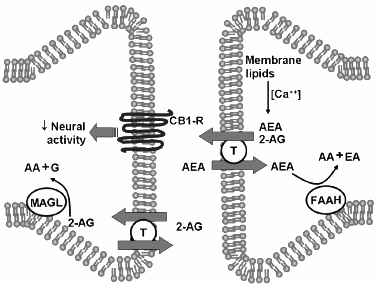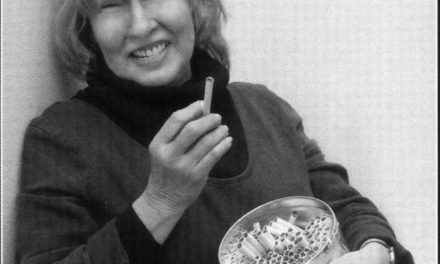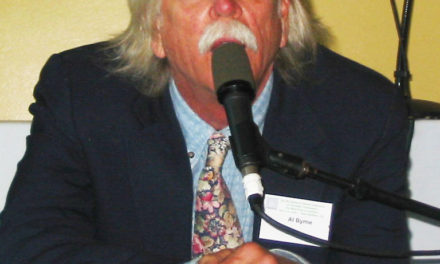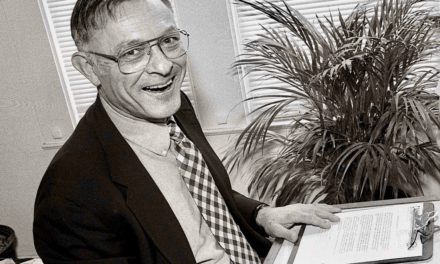O’Shaughnessy’s is produced for the doctors of the California Cannabis Research Medical Group by the managing editor. It is meant to be read by patients, as well. It is an instrument of continuing education —mine, yours, ours.
Our first issue, Summer 2003, carried an item from the International Cannabinoid Research Society meeting in Asilomar: “There is growing evidence that anandamide works as a ‘retrograde messenger,’ causing the other receptor systems to slow down when they’re firing too much.
“‘The endocannabinoids appear to be released by post-synaptic neurons and travel backwards across the synapse to inhibit neurotransmitter release from the presynaptic neurons,’ is how Gregory Gerdeman of the University of Arizona summarized this year’s highlight…”
There’s something satisfying about the likeness between how cannabinoids work on the neuronal level —toning down signals depending on the need downstream— and their overall modulating effect on the mind and body.
Even before the biochemists reached their current level of understanding, CCRMG founder Tod Mikuriya, MD, inferred from the effects cannabis has on people that its mode of action was unique and that it modulated multiple systems within the body. Mikuriya presented a poster at the 2001 ICRS meeting explaining why “sedative,” and “hallucinogen” were inadequate descriptions, and proposing that cannabis be categorized as an “easement” and listed on a schedule of its own.
He also urged that cannabis be grandfathered into the U.S. formulary on the grounds that its safety and efficacy had been established prior to its being banned in 1937. “Back to the future,” is a slogan he often employs. A succinct retrograde message.
We can extend the analogy in many directions. Just as the endocannabinoids modulate many systems within the body, the marijuana issue relates to almost all the major issues of our day (healthcare costs and addiction to oil for openers).
The doctor-patient relationship becomes retro when the treatment involved is cannabis. Instead of the doctor telling the patient what to do for the illness, the patient becomes a retrograde messenger, transmitting to the doctor —who learned nothing about cannabis in medical school, or from the drug-company sales reps who provide his or her continuing miseducation— information about how it is used medicinally.
In the process, the patient is honest with the doctor about his or her cannabis use. This in itself is a reversal of the norm. Although lip-service is always paid to “the sanctity of the doctor-patient relationship,” Prohibition has made millions of patients afraid to even tell their doctor that they use cannabis. Those who do often learn that their doctors are afraid politically or unwilling out of sincere humility (having had no training in cannabis therapeutics) to issue an approval.g.
The culture at large is in need of some serious retrograde messaging. The lies transmitted incessantly by the corporate state —billions of pulses coming at us from TV and auxiliary sources— need to be toned way, way down and calmly refuted. Who is better-suited to do this than the millions of citizens who know that the corporate state and media are lying about marijuana?
There is no other issue on which the American people know for sure that the government lying. Most people know first-hand or from someone they trust that marijuana has medicinal properties and is relatively harmless. They don’t know first-hand or from someone they trust that Enron designed U.S. energy policy or that the oil companies dispatched the U.S. military to Iraq to secure 24% of the world’s reserves. On such matters, many can be misled.
But not on marijuana. And as more grannies and aunties make it through chemo thanks to marijuana, as more cops in cities like Chico (home to a college infamous for binge drinking) see cannabis as a benign alternative to alcohol, as more doctors are educated on the subject, the American people are going to become increasingly pro-cannabis.
Constraints on Research
Research that needs to be done, obviously, will determine which components of the cannabis plant cause which effects, so that plants can be bred with desired canabinoid ratios. There are California growers capable of doing this work —keen to do it— all they need is access to an analytical test lab.
Clinical research in cannabis therapeutics has been drastically constricted by Prohibition because patients and caregivers can’t develop and test plant strains with varying cannabinoid ratios.
Cannabis therapeutics will come into its own as a specialty and research will flourish when growers are allowed to develop strains featuring cannabinoids other than THC. It seems ironic —given that THC is the psychoactive component in cannabis, responsible for the unacceptable side effect, “euophoria”— that Prohibition is preventing patients in California from developing alternative strains.
Waiting for Raich
This issue appears at a time when the medical marijuana movement/industry has been expanding rapidly —more patients getting approvals from more doctors, more dispensaries opening up and down the state, more people growing their own medicine and feeling relatively safe thanks to a series of court rulings —including a federal-court ruling that protects the right of doctors and patients to discuss cannabis on First Amendment grounds.
Yet the Supreme Court ruling in the Raich case casts an ominous shadow. In a commonly discussed worst-case scenario, the Court rules for the government and the DEA begins raiding California dispensaries and growers. Everyone’s terror level, including patients’ and doctors, goes to code red. The growth of the movement/industry is stunted as millions of Californians who could use cannabis beneficially and economically but have yet to request a doctor’s approval decide not to try.
For patients who grow their own medicine, however, or do so through a co-op, a negative Raich decision changes nothing but the political atmosphere, according to most lawyers willing to venture a prediction.
An attorney who has respectful relations with the U.S. Attorney’s office in San Francisco advises, “The feds don’t have the resources to go after individual patients. Their attitude is, ‘If they’re big or if they get in our face, we’re going to go after them. ‘ So don’t be big and don’t go public. Don’t have a huge grow. Don’t have a website. Don’t do things the feds might interpret as taunting.”
“Respect the federal sentencing guidelines. Grow fewer than 100 plants and you should have nothing to fear but fear itself.”
Live in fear. Keep your head way down. Lie like everybody else in this society and maybe you’ll be spared. Nice deal.
The Virtues of the Co-op
Anticipating an interest in co-ops, we asked a business specialist how they work. A bona fide cooperative abides by certain key principles, starting with one person, one vote. The members pay to belong to the co-op because they want certain things to happen (for example, a Ventura orange grower joins Sunkist to reach the New York market). Members vote for a board, the board has a manager, the manager gets paid.
The original food co-ops in Northern California wanted to have organic food and had to be in control of their business to assure it. Today the food co-op in Davis is a big supermarket, but it’s still a co-op. At the end of the year, after all the expenses of the co-op have been paid out, members get a patronage refund —a precise fraction of the grocery store’s surplus, based on how much they spent there.
In a cannabis cultivation co-op, caregivers are allowed to get reimbursed for their expenses (water, fertilizer, electricity, lights and, arguably, money set aside in anticipation of legal costs); and to be reasonably compensated. No court has yet to address the definition of “reasonable compensation.”
“Some people don’t want to go co-op because they think they’ll lose control,” says our business specialist. “But it’s the most protection, including protection from the feds. No one’s going to go after patients.”
The state law created in 2003 by SB 420 explicitly promotes “collective cooperative cultivation” projects. Some activists now entertain the hope that the DEA, by picking off a few big operators, will impose a “mom-and-pop” character on the medical marijuana industry —an outcome they frankly would welcome.
Educate, Educate, Educate!
In any event, the U.S. Supreme Court ruling in the Raich case will not affect the right of doctors and patients to discuss cannabis as a treatment option. Nor will it affect our right to educate others, i.e., to carry the message that cannabis is safe and effective medicine.
As this issue rolled off the press, the USC Keck School of Medicine held its second annual elective course on cannabis therapeutics, organized by CCRMG member Claudia Jensen, MD. Philip Denney of the CCRMG prepared a lecture outlining, in half an hour, everything that a first- or second-year med student needs to know about cannabis as medicine.
Denney and other CCRMG doctors are ready, willing, and able to give classes (students at UCSF and other California medical schools should let their deans know) and talks at teach-ins and grand rounds. Contact journal@ccrmg to discuss organizing an educational event at your school, hospital, or other setting.
Our strategy is simple: educate, educate, educate. Even a worst-case-scenario in the Raich case is only a minor setback on the legal front. On the scientific front we are impregnable.
We refer, of course, to real science, not corporate-state science.
Real science is refined common sense. It respects anecdotal evidence and designs experiments to confirm or deny its significance. Corporate-state science hides data that would hurt sales. Real science is about truth and human welfare. Corporate-state science commits murder after doing a cost/benefit analysis. — Fred Gardner O’Shauhnessy’s Spring 2005





